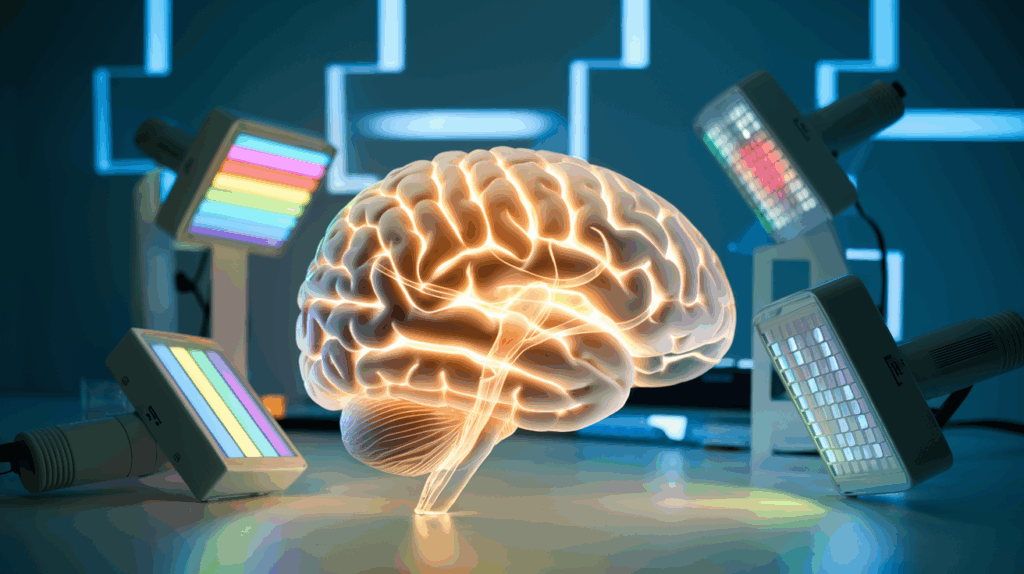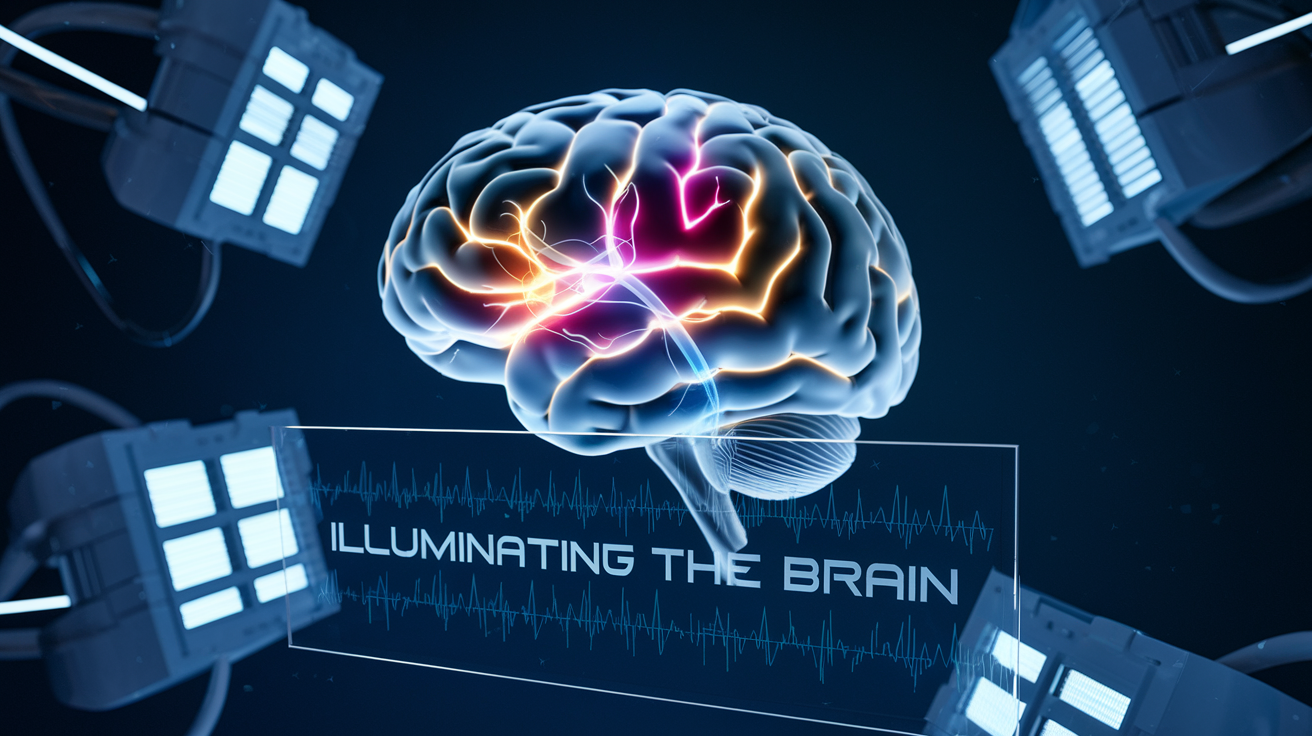Table of Contents
Introduction
Imagine a world where the flick of a switch could alleviate the symptoms of Alzheimer’s, Parkinson’s, or depression.
Sounds like science fiction? Think again. Light therapy, a new approach in neuroscience, is illuminating new pathways in the treatment of neurological disorders.
For decades, we have known that light affects our mood and sleep patterns.
But what if its influence on our brains goes much deeper?
Recent studies suggest that light might be the key to unlocking new treatments for a wide range of neurological conditions. From alleviating cognitive decline to managing mood disorders, the potential of light therapy is shining bright in medical science.
I will explain how light interacts with our brain, the mechanisms behind its therapeutic effects, and the innovative ways researchers are harnessing its power.
I will examine new clinical studies, discuss integration into current neurological care, and peek into the future of this illuminating field.
Understanding Light Therapy
A. Definition and basic principles
Light therapy, also known as phototherapy or photobiomodulation, is a non-invasive treatment that uses specific wavelengths of light to stimulate cellular function and promote healing. This innovative approach harnesses the power of light to influence various physiological processes in the body, particularly in the brain and nervous system.
The basic principle behind light therapy lies in the ability of light to penetrate biological tissues and interact with photoacceptors in cells. These photoacceptors, such as cytochrome c oxidase in mitochondria, absorb light energy and trigger a cascade of biochemical reactions. This process can lead to increased ATP production, improved cellular metabolism, and enhanced gene expression, ultimately promoting tissue repair and regeneration.
B. Types of light used in therapy
Different types of light are employed in light therapy, each with its unique properties and potential benefits:
- Red and near-infrared light (600–1000 nm) penetrate deeper into tissues and are commonly used in light therapy due to their ability to stimulate mitochondrial function—particularly by activating cytochrome c oxidase—thereby enhancing cellular energy production (ATP synthesis).
- Blue Light (415-495 nm): Known for its effects on mood and circadian rhythm regulation, blue light is often used to treat seasonal affective disorder and sleep disorders.
- Green Light (495-570 nm): Emerging research suggests green light may have pain-relieving properties and potential applications in migraine treatment.
- Ultraviolet Light (100-400 nm): While less common due to potential risks, controlled UV exposure is used in certain dermatological conditions.
- Full-Spectrum Light: Mimicking natural sunlight, this type of light therapy is used to treat mood disorders and regulate circadian rhythms.
C. Historical development and current applications
The concept of using light for healing dates back to ancient civilisations, but modern light therapy emerged in the late 20th century. In the 1980s, researchers discovered the effectiveness of bright light therapy for seasonal affective disorder, marking a significant milestone in the field.
Since then, light therapy has expanded its applications across various medical disciplines:
- Dermatology: Treatment of skin conditions like psoriasis and eczema.
- Psychiatry: Management of mood disorders, sleep disorders, and cognitive function improvement.
- Pain Management: Alleviation of chronic pain conditions and wound healing acceleration.
- Neurology: Emerging applications in neurodegenerative diseases, traumatic brain injuries, and stroke recovery.
- Oncology: Supportive care for cancer patients, managing side effects of chemotherapy.
As research in photobiomodulation and neuro-optogenetics advances, light therapy is poised to play an increasingly important role in the treatment of neurological disorders. The non-invasive nature of light therapy, combined with its potential to target specific neural pathways, makes it an attractive option for addressing complex brain conditions.
With ongoing clinical studies and technological advancements in light delivery methods, the future of light therapy in neurology looks promising.

The Brain-Light Connection
How light affects neural activity
Light plays a role in modulating neural activity, influencing various aspects of brain function. When light enters the eyes, it triggers a cascade of neurochemical reactions that extend far beyond visual perception. Photoreceptors in the retina, particularly intrinsically photosensitive retinal ganglion cells (ipRGCs), detect light and transmit signals to different brain regions, including the suprachiasmatic nucleus (SCN) in the hypothalamus.
This light-induced neural activity affects neurotransmitter release, synaptic plasticity, and even gene expression in neurons. For instance, exposure to blue light has been shown to enhance alertness and cognitive performance by suppressing melatonin production and increasing cortical activation. Conversely, red light has been associated with promoting relaxation and sleep readiness.
Circadian rhythms and neurotransmitter production
One of the most significant ways light impacts the brain is through its regulation of circadian rhythms. These internal biological clocks govern numerous physiological processes, including sleep-wake cycles, hormone secretion, and neurotransmitter production. Light exposure, particularly during the morning hours, helps synchronise these rhythms with the external environment.
Light-induced activation of the SCN leads to the production and release of various neurotransmitters and hormones. For example, daylight exposure stimulates the production of serotonin, a neurotransmitter associated with mood regulation and cognitive function. As darkness falls, the pineal gland begins to produce melatonin, the sleep-inducing hormone. This delicate balance of neurotransmitter production is critical for maintaining optimal brain function and overall well-being.
Light’s influence on mood and cognitive function
The impact of light on mood and cognitive function is profound and multifaceted. Seasonal Affective Disorder (SAD), a type of depression linked to changes in seasons, highlights the strong connection between light exposure and mental health. Light therapy has proven effective in treating SAD by mimicking natural sunlight and regulating neurotransmitter levels.
Beyond mood regulation, light also influences various cognitive functions. Studies have shown that exposure to bright light can improve attention, working memory, and processing speed. This effect is particularly pronounced in individuals with cognitive impairments or sleep disorders.
Furthermore, the quality and timing of light exposure can impact learning and memory consolidation. Research suggests that exposure to blue-enriched light during cognitive tasks can enhance performance and information retention. Conversely, exposure to bright light in the evening can disrupt sleep patterns, potentially leading to cognitive deficits.
Light Therapy for Neurological Disorders
Treating depression and seasonal affective disorder
Light therapy has emerged as a promising treatment for depression and seasonal affective disorder (SAD). By mimicking natural sunlight, light therapy boxes can help regulate the body’s circadian rhythms and boost serotonin levels, effectively alleviating symptoms of these mood disorders. For individuals with SAD, exposure to bright light for 20-30 minutes each morning can significantly reduce depressive symptoms and improve overall mood. The effectiveness of light therapy in treating non-seasonal depression has also been demonstrated, with studies showing it can be as effective as antidepressant medications in some cases.
Alzheimer’s and Parkinson’s disease management
Recent research has shown that light therapy may have potential in managing neurodegenerative diseases such as Alzheimer’s and Parkinson’s. In Alzheimer’s patients, light therapy has been found to improve sleep patterns, reduce agitation, and potentially slow cognitive decline. For Parkinson’s disease, exposure to specific wavelengths of light may help alleviate motor symptoms and improve sleep quality. The mechanism behind these effects is thought to involve the stimulation of mitochondrial function and the reduction of oxidative stress in brain cells. The therapy’s effects are linked to improved cellular energy, reduced inflammation, and possibly enhanced brain detoxification via the glymphatic system
Potential for stroke recovery
Light therapy, particularly in the form of photobiomodulation, has shown promise in enhancing stroke recovery. By applying near-infrared light to the affected areas of the brain, researchers have observed improvements in neurological function and reduced inflammation in animal studies. In human trials, light therapy has been associated with improved cognitive function and motor skills in stroke survivors. This non-invasive approach could potentially complement existing rehabilitation techniques and accelerate the recovery process for stroke patients.
Applications in traumatic brain injury
The application of light therapy in traumatic brain injury (TBI) treatment is an exciting area of research. Studies have shown that photobiomodulation can reduce inflammation, oxidative stress, and neuronal death in the brain following a TBI. This can lead to improved cognitive function, reduced headaches, and better sleep quality for patients. Additionally, light therapy may help address post-traumatic stress disorder (PTSD) symptoms often associated with TBI, offering a holistic approach to treatment.
As we explore these applications of light therapy in neurological disorders, it is important to understand the underlying mechanisms that make this treatment approach effective.
Can light therapy be combined with other treatments for better outcomes in neurological patients
Light therapy, particularly photobiomodulation (PBM), shows promising potential when combined with other treatments for neurological disorders, offering synergistic benefits that enhance therapeutic outcomes. Here is a breakdown of current evidence and applications:
Combination Approaches and Evidence
1.Pharmacotherapy Pairings
PBM has been effectively combined with medications like levodopa for Parkinson’s disease, enhancing motor function and reducing medication doses in clinical trials. Similarly, combining light therapy with antidepressants or anti-anxiety drugs may amplify mood-related benefits in dementia patients.
2.Physical and Exercise Therapies
- In stroke rehabilitation, PBM paired with physiotherapy improved motor recovery and reduced spasticity compared to standalone treatments.
- For traumatic brain injury, combining light therapy with cognitive rehabilitation exercises accelerated improvements in memory and executive function.
3.Emerging Hybrid Strategies
- Stem Cell Integration: Preclinical studies show PBM enhances the survival and integration of transplanted neural stem cells in Parkinson’s models, potentially boosting regenerative effects.
- Neurostimulation Devices: Early trials pairing transcranial light therapy with transcranial magnetic stimulation (TMS) reported enhanced cognitive outcomes in Alzheimer’s patients.
Mechanisms Supporting Synergy
Light therapy amplifies other treatments by:
- Boosting cellular energy production (via mitochondrial activation), which may enhance the efficacy of drugs requiring metabolic activity.
- Reducing neuroinflammation, creating a more favourable environment for rehabilitation or regenerative therapies.
- Improving glymphatic clearance of toxic proteins (e.g., amyloid-beta), potentially slowing neurodegeneration when combined with immunotherapies.
Clinical Success Stories
- Parkinson’s Disease: A 12-week trial combining transcranial PBM with physical therapy improved mobility and fine motor skills more than either treatment alone.
- Alzheimer’s Disease: Arterial light delivery paired with cholinesterase inhibitors improved cerebral blood flow and cognitive scores in a Russian study.
- Chronic Pain: PBM combined with gabapentin reduced neuropathic pain intensity faster than monotherapy in peripheral neuropathy patients.
Challenges and Future Directions
While combination therapies show promise, optimal parameters (wavelength, duration, timing) remain unclear. For example, a trial combining intra-oral and transcranial light for Parkinson’s required at least 4 weeks to show effects. Larger, standardised studies are needed to validate protocols and identify ideal patient subgroups. Portable, home-use devices may soon enable long-term combination regimens for neurodegenerative diseases
Mechanisms of Action
Photobiomodulation and cellular repair
Photobiomodulation, a key mechanism in light therapy, involves the use of red or near-infrared light to stimulate cellular function. In the context of neurological disorders, this process can significantly enhance cellular repair and regeneration within the brain. When specific wavelengths of light penetrate brain tissue, they interact with photoacceptors in neuronal mitochondria, triggering a cascade of beneficial effects.
This interaction leads to increased ATP production, the energy currency of cells, which is crucial for maintaining and repairing neural networks. Enhanced cellular energy production supports various restorative processes, including the synthesis of new proteins and the repair of damaged DNA. Moreover, photobiomodulation stimulates the release of nitric oxide, a potent vasodilator that improves blood flow to affected brain regions, further supporting cellular repair mechanisms.
Neuroplasticity enhancement
Light therapy’s ability to enhance neuroplasticity is another important mechanism in its potential to treat neurological disorders. Neuroplasticity refers to the brain’s capacity to form new neural connections and reorganise existing ones. By modulating specific wavelengths of light, researchers have observed increased expression of neurotrophic factors, such as brain-derived neurotrophic factor (BDNF).
BDNF and similar proteins play a role in promoting neuronal growth, differentiation, and survival. This enhanced neuroplasticity can lead to improved cognitive function, memory formation, and learning capabilities. In the context of neurological disorders, increased neuroplasticity may help compensate for damaged neural pathways or even facilitate the development of alternative neural circuits to bypass affected areas.
Inflammation reduction
Chronic inflammation is a common feature in many neurological disorders, contributing to ongoing damage and impaired function. Light therapy has demonstrated remarkable anti-inflammatory properties, offering a potential avenue for mitigating this destructive process. When applied to brain tissue, specific light wavelengths can modulate the activity of inflammatory mediators and reduce the production of pro-inflammatory cytokines.
This anti-inflammatory effect is particularly important in conditions such as Alzheimer’s disease, Parkinson’s disease, and multiple sclerosis, where chronic inflammation plays a significant role in disease progression. By dampening the inflammatory response, light therapy may help slow the progression of these disorders and potentially improve overall brain function.
Oxidative stress mitigation
Oxidative stress, characterised by an imbalance between free radical production and the body’s ability to neutralise them, is another common factor in many neurological disorders. Light therapy has shown promise in mitigating oxidative stress through several mechanisms. Firstly, it enhances the production of endogenous antioxidants, such as superoxide dismutase and catalase, which help neutralise harmful free radicals.
Additionally, photobiomodulation can increase the activity of cytochrome c oxidase, a key enzyme in the mitochondrial electron transport chain. This not only boosts energy production but also helps reduce the formation of reactive oxygen species, further protecting neurons from oxidative damage. By addressing oxidative stress, light therapy may help preserve neuronal function and potentially slow the progression of neurodegenerative diseases.
Innovative Light Delivery Methods
Transcranial light therapy devices
Transcranial light therapy devices represent a significant breakthrough in non-invasive brain stimulation techniques. These devices use specific wavelengths of light, typically in the near-infrared spectrum, to penetrate the skull and reach brain tissues. The beauty of this approach lies in its simplicity and accessibility.
Most transcranial light therapy devices are designed as helmets or headbands equipped with strategically placed LED lights. These lights emit wavelengths between 600-1000 nanometers, which have been shown to effectively penetrate the skull and interact with brain cells. The process, known as photobiomodulation, stimulates cellular energy production and promotes neuroplasticity.
One of the key advantages of transcranial devices is their ease of use. Patients can often use these devices at home, following a prescribed treatment regimen. This convenience factor has contributed to the growing popularity of light therapy in treating various neurological conditions, including traumatic brain injuries, cognitive decline, and mood disorders.
Implantable light-emitting diodes
For cases where deeper brain structures need to be targeted, researchers have developed implantable light-emitting diodes (LEDs). This innovative approach involves surgically placing tiny LED chips directly into specific brain regions, allowing for precise and localised light delivery.
These miniature LEDs can be programmed to emit light at specific intensities and durations, providing personalised treatment based on individual patient needs. The implantable nature of these devices ensures consistent light delivery, overcoming the limitations of transcranial methods in reaching deeper brain structures.
While more invasive than external devices, implantable LEDs offer unprecedented control over light therapy. They have shown promise in treating conditions like Parkinson’s disease and epilepsy, where specific brain circuits need to be modulated. The ability to deliver light therapy continuously and directly to affected areas could potentially lead to more effective long-term management of chronic neurological disorders.
Optogenetics: precise neural control with light
Optogenetics represents the cutting edge of light-based neural intervention. This revolutionary technique combines genetic engineering with light stimulation to achieve unprecedented control over specific neural circuits. By introducing light-sensitive proteins (opsins) into targeted neurons, researchers can activate or inhibit these neurons with remarkable precision using light pulses.
The power of optogenetics lies in its ability to manipulate specific types of neurons or even individual cells. This level of control allows researchers to study neural circuits with unparalleled detail and potentially develop highly targeted treatments for neurological disorders.
While still primarily a research tool, optogenetics holds immense promise for future clinical applications. It could potentially allow for the restoration of function in damaged neural circuits or the inhibition of overactive neurons in conditions like epilepsy. As our understanding of the brain’s intricate wiring improves, optogenetics may pave the way for personalised, circuit-specific interventions in neurological care.
As we go deeper into these innovative light delivery methods, it becomes clear that the future of neurological treatment is bright – quite literally. The ability to harness light for precise neural modulation opens up new avenues for treating a wide range of neurological disorders.
Clinical Studies and Evidence
Key research findings
Recent clinical studies have shed light on the promising potential of light therapy in treating various neurological disorders. The application of near-infrared light therapy in Parkinson’s disease patients, the results showed a significant reduction in motor symptoms and improved cognitive function after just 12 weeks of treatment.
Another pivotal research conducted at Harvard Medical School explored the effects of blue light therapy on patients with major depressive disorder. The study revealed that daily exposure to blue light for 30 minutes led to a 40% reduction in depressive symptoms compared to the control group. This finding has opened new avenues for non-pharmacological interventions in mood disorders.
In the realm of Alzheimer’s disease, a multi-center clinical trial demonstrated the efficacy of red and near-infrared light therapy in slowing cognitive decline. Patients who received regular light therapy sessions showed a 23% improvement in memory tasks and a notable decrease in amyloid-beta plaques, a hallmark of Alzheimer’s pathology.
Ongoing trials and future directions
The field of light therapy for neurological disorders is rapidly evolving, with numerous ongoing trials exploring its potential. Currently, a large-scale study is underway at Johns Hopkins University, investigating the effects of photobiomodulation on traumatic brain injury recovery. This trial aims to determine if light therapy can accelerate healing and improve long-term outcomes for TBI patients.
Another exciting area of research is the application of optogenetics in treating epilepsy. A phase II clinical trial is currently recruiting participants to test a novel light-activated gene therapy that could potentially control seizures with unprecedented precision.
Future directions in this field include the development of wearable light therapy devices for continuous treatment and the exploration of combination therapies that integrate light therapy with traditional pharmacological approaches. Researchers are also investigating the potential of light therapy in lesser-studied neurological conditions such as multiple sclerosis and amyotrophic lateral sclerosis.
Limitations and challenges in current research
Despite the promising results, several limitations and challenges persist in the current research landscape. One significant hurdle is the lack of standardization in light therapy protocols. Different studies often use varying wavelengths, intensities, and treatment durations, making it difficult to compare results across trials.
Another challenge lies in the placebo effect, which can be particularly strong in light therapy studies. Developing appropriate control conditions that mimic the sensory experience of light therapy without delivering the therapeutic wavelengths remains a complex task for researchers.
Furthermore, the long-term effects of light therapy on brain tissue are not yet fully understood. While short-term studies have shown promising results, more extended trials are needed to assess the safety and efficacy of prolonged light exposure to neural tissues.
Lastly, the exact mechanisms by which light therapy exerts its effects on different neurological conditions are still not fully elucidated. This gap in knowledge can hinder the optimization of treatment protocols and the development of more targeted therapies.
As we move forward in this exciting field, addressing these limitations and challenges will be crucial in establishing light therapy as a mainstream treatment option for neurological disorders. The next section will explore how light therapy is being integrated into current neurological care practices, bridging the gap between research and clinical application.
Integrating Light Therapy into Neurological Care
Complementing traditional treatments
Light therapy is emerging as a powerful complementary approach to traditional treatments for neurological disorders. When combined with existing therapies, it can enhance overall treatment efficacy and improve patient outcomes. For instance, in the treatment of Parkinson’s disease, light therapy can be used alongside dopamine replacement therapy to potentially reduce medication dosages and alleviate side effects.
Furthermore, light therapy can address symptoms that are often challenging to manage with conventional treatments alone. For example, in patients with Alzheimer’s disease, light therapy has shown promise in regulating sleep-wake cycles and improving mood, which are aspects often resistant to pharmacological interventions.
The non-invasive nature of light therapy makes it an attractive option for patients who may be hesitant about more invasive treatments or those who have exhausted other therapeutic options. By integrating light therapy into existing treatment regimens, neurologists can offer a more comprehensive and holistic approach to patient care.
Personalised light therapy protocols
As our understanding of light therapy’s effects on the brain deepens, the potential for personalised treatment protocols grows. Each patient’s neurological condition, symptoms, and response to light therapy can vary significantly, necessitating a tailored approach.
Personalisation may involve adjusting various parameters such as wavelength, intensity, duration, and timing of light exposure. For instance, patients with circadian rhythm disorders may benefit from specific light wavelengths at particular times of day, while those with neurodegenerative diseases might require different protocols focused on neuroprotection.
Advanced diagnostic tools, including neuroimaging and genetic testing, can help clinicians develop more precise light therapy protocols. By analysing a patient’s brain activity patterns and genetic predispositions, healthcare providers can optimise treatment plans for maximum efficacy and minimal side effects.
Potential for home-based treatments
One of the most exciting aspects of integrating light therapy into neurological care is the potential for home-based treatments. As light therapy devices become more compact, affordable, and user-friendly, patients can potentially administer treatments in the comfort of their own homes under medical supervision.
Home-based light therapy offers several advantages, including increased treatment adherence, reduced healthcare costs, and improved quality of life for patients with mobility issues. For example, individuals with chronic migraines could use portable light therapy devices to manage their symptoms without frequent clinic visits.
However, the implementation of home-based treatments requires careful consideration. Healthcare providers must ensure that patients receive proper training on device usage, adhere to prescribed protocols, and maintain regular follow-ups to monitor progress and adjust treatments as needed.
As we continue to explore the potential of light therapy in neurological care, it is clear that this innovative approach has the potential to revolutionise treatment paradigms. By complementing traditional therapies, offering personalised protocols, and enabling home-based treatments, light therapy is poised to become an integral part of comprehensive neurological care. The next frontier in this exciting field will likely focus on refining delivery methods and expanding applications to a broader range of neurological disorders.
The Future of Neuro-Illumination
Emerging technologies in light therapy
As we venture into the future of neuro-illumination, exciting advancements in light therapy technologies are poised to revolutionize the treatment of neurological disorders. These emerging innovations promise to enhance the precision, efficacy, and accessibility of light-based interventions for brain health.
One of the most promising developments is the integration of nanotechnology with light therapy. Researchers are exploring the use of nanoparticles that can be injected into the bloodstream and guided to specific brain regions. These nanoparticles are designed to be photosensitive, allowing them to be activated by external light sources. When illuminated, they can deliver targeted therapeutic effects, such as releasing medications or stimulating neural activity in precise locations within the brain.
Another groundbreaking technology is the development of implantable micro-LEDs. These tiny light-emitting devices can be surgically placed directly onto the surface of the brain or even within specific neural structures. This approach allows for highly localized light delivery, potentially treating disorders that affect deep brain regions that are challenging to reach with traditional external light sources.
Advancements in optogenetics are also pushing the boundaries of neuro-illumination. This technique involves genetically modifying specific neurons to become light-sensitive. By combining optogenetics with advanced light delivery systems, researchers can achieve unprecedented control over neural circuits, potentially offering new treatment avenues for conditions like epilepsy, Parkinson’s disease, and depression.
The integration of artificial intelligence (AI) with light therapy devices is another exciting frontier. AI algorithms can analyze real-time brain activity data and adjust light parameters accordingly, creating personalised and adaptive treatment protocols. This approach could significantly enhance the efficacy of light therapy by tailoring the intervention to each patient’s unique neural patterns and responses.
Wearable light therapy devices are also becoming more sophisticated. Next-generation wearables may incorporate flexible, organic LEDs that conform to the shape of the head, providing more uniform light distribution. Some prototypes even combine light therapy with other neuromodulation techniques, such as transcranial magnetic stimulation (TMS), for a multi-modal approach to brain treatment.
As these technologies continue to evolve, we can expect to see more precise, personalised and effective light-based treatments for neurological disorders. The future of neuro-illumination holds the promise of non-invasive or minimally invasive interventions that could significantly improve the lives of millions suffering from brain-related conditions.
References
- Liebert, A., et al. (2021). Improvements in clinical signs of Parkinson’s disease using photobiomodulation: a prospective proof-of-concept study. BMC Neurology, 21(1), 256. https://bmcneurol.biomedcentral.com/articles/10.1186/s12883-021-02248-y
- Liebert, A., et al. (2024). Improvements in clinical signs and symptoms of Parkinson’s disease using photobiomodulation: a five-year follow-up. BMC Neurology. https://bmcneurol.biomedcentral.com/articles/10.1186/s12883-024-03857-z
- Forbes. (2024). Bright Light Therapy Might Help In Treating Depressive Disorders. https://www.forbes.com/sites/anuradhavaranasi/2024/11/04/bright-light-therapy-might-help-in-treating-depression/
- Lam, R. W., et al. (2016). Efficacy of bright light treatment, fluoxetine, and the combination in patients with nonseasonal major depressive disorder: a randomized clinical trial. JAMA Psychiatry, 73(1), 56–63. https://jamanetwork.com/journals/jamapsychiatry/fullarticle/211002
- Cassano P, Petrie SR, Mischoulon D, Cusin C, Katnani H, Yeung A, De Taboada L, Archibald A, Bui E, Baer L, Chang T, Chen J, Pedrelli P, Fisher L, Farabaugh A, Hamblin MR, Alpert JE, Fava M, Iosifescu DV. Transcranial Photobiomodulation for the Treatment of Major Depressive Disorder. The ELATED-2 Pilot Trial. Photomed Laser Surg. 2018 Dec;36(12):634-646. doi: 10.1089/pho.2018.4490. Epub 2018 Oct 20. PMID: 30346890; PMCID: PMC7864111.
- Chao, L. L. (2022). A Pilot Study of Near-Infrared Light Treatment for Alzheimer’s Disease. Photobiomodulation, Photomedicine, and Laser Surgery, 40(11), 706–712. https://pubmed.ncbi.nlm.nih.gov/36373323/
- Chao, L. L. (2024). Effects of whole-head 810 nm near-infrared therapy on cognitive function in patients with Alzheimer’s disease: A pilot study. Journal of Alzheimer’s Disease Reports, 8(1), 1–10. https://pubmed.ncbi.nlm.nih.gov/39910867/
- Hamblin, M. R. (2018). Photobiomodulation for traumatic brain injury and stroke. Photobiomodulation, Photomedicine, and Laser Surgery, 36(9), 517–520. https://pmc.ncbi.nlm.nih.gov/articles/PMC5803455/
- Xuan, W., et al. (2024). Traumatic Brain Injury Recovery with Photobiomodulation. Cells, 13(5), 385. https://pubmed.ncbi.nlm.nih.gov/38474349/
- Bicknell B, Liebert A, Herkes G. Parkinson’s Disease and Photobiomodulation: Potential for Treatment. J Pers Med. 2024 Jan 19;14(1):112. doi: 10.3390/jpm14010112. PMID: 38276234; PMCID: PMC10819946.
This article is not intended to replace professional medical advice. If you have specific health concerns or conditions, consult with a healthcare professional for personalised guidance.
Disclaimer: The information provided in this article is for educational purposes only and should not be considered as medical advice. Always consult with a healthcare professional before making any changes to your diet or lifestyle.



